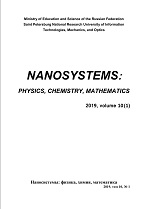|
PHYSICS
Peristaltic pumping through non-Darcy porous medium in an electroosmotic flow with entropy analysis
Bhimanand Pandurang Gajbhareab, J. S. V. R. Krishna prasadc, S. R. Mishrad
a Research Scholar, Kavayitri Bahinabai Chaudhari North Maharashtra University, Jalgaon, India
b Department of Mathematics, Vaidyanath College Parli-Vaijanath, Beed-431515, Maharashtra, India
c Department of Mathematics, Moolji Jaitha College, Jalgaon-425001, Maharashtra, India
d Department of Mathematics, Siksha O Anusandhan Deemed to be University, Khandagiri square,
Bhubaneswar-751030, Odisha, India
Abstract:
Pumping of peristaltic fluid is a vehicle via liquid that is accomplished due to a dynamic rush through a distensible cylinder containing liquids which extends along its length. Peristaltic pumping occurs in a lower pressure region to a higher pressure region. As a principle of peristaltic pumping, various applications are used for the blood pumping in different parts of the human body, pharmacological drug delivery systems and in industries, sanitary fluid transport, etc. Therefore, peristaltic pumping via a non-Darcy porous medium in an electroosmotic flow has been discussed in the current investigation. To exhibit the existence of a porous medium, Darcy Forchheimer model is deployed. The electro-magnetohaydrodynamic flow of fluid passing a symmetric channel and the novelty of the study are due to the entropy analysis. Analytical approach such as perturbation technique is employed to reduce the higher order coupled transformed equation into its lower order decoupled form and then numerical treatment is made to obtain the approximate solutions. The characteristics of the contributing parameters are presented via graphs and the numerical computations are exhibited through tabular form. Present outcome warrants a good correlation with earlier result in particular case. However, the main findings are elaborated in the results and discussion section.
Keywords:
electroosmotic flow, peristaltic pumping, Darcy-Forchheimer model, approximate analytical method, perturbation technique.
Received: 30.03.2020
Revised: 15.07.2020
Citation:
Bhimanand Pandurang Gajbhare, J. S. V. R. Krishna prasad, S. R. Mishra, “Peristaltic pumping through non-Darcy porous medium in an electroosmotic flow with entropy analysis”, Nanosystems: Physics, Chemistry, Mathematics, 11:4 (2020), 379–390
Linking options:
https://www.mathnet.ru/eng/nano537 https://www.mathnet.ru/eng/nano/v11/i4/p379
|

| Statistics & downloads: |
| Abstract page: | 53 | | Full-text PDF : | 65 |
|




 Contact us:
Contact us: Terms of Use
Terms of Use
 Registration to the website
Registration to the website Logotypes
Logotypes








 Citation in format
Citation in format 